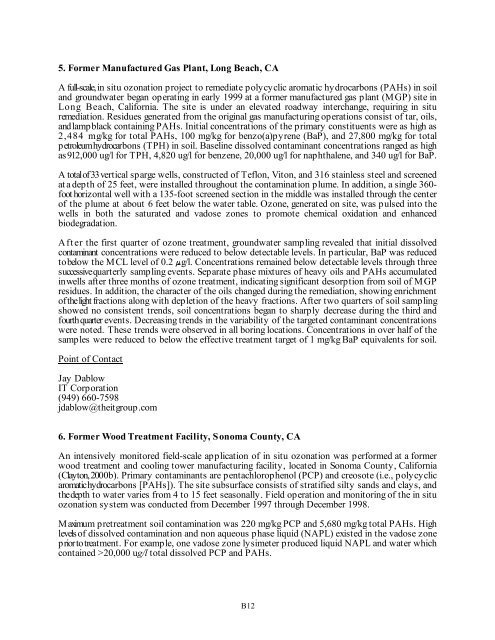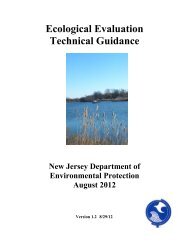Technical and Regulatory Guidance for In Situ Chemical ... - ITRC
Technical and Regulatory Guidance for In Situ Chemical ... - ITRC
Technical and Regulatory Guidance for In Situ Chemical ... - ITRC
You also want an ePaper? Increase the reach of your titles
YUMPU automatically turns print PDFs into web optimized ePapers that Google loves.
5. Former Manufactured Gas Plant, Long Beach, CA<br />
A full-scale, in situ ozonation project to remediate polycyclic aromatic hydrocarbons (PAHs) in soil<br />
<strong>and</strong> groundwater began operating in early 1999 at a <strong>for</strong>mer manufactured gas plant (MGP) site in<br />
Long Beach, Cali<strong>for</strong>nia. The site is under an elevated roadway interchange, requiring in situ<br />
remediation. Residues generated from the original gas manufacturing operations consist of tar, oils,<br />
<strong>and</strong> lampblack containing PAHs. <strong>In</strong>itial concentrations of the primary constituents were as high as<br />
2,484 mg/kg <strong>for</strong> total PAHs, 100 mg/kg <strong>for</strong> benzo(a)pyrene (BaP), <strong>and</strong> 27,800 mg/kg <strong>for</strong> total<br />
petroleum hydrocarbons (TPH) in soil. Baseline dissolved contaminant concentrations ranged as high<br />
as 912,000 ug/l <strong>for</strong> TPH, 4,820 ug/l <strong>for</strong> benzene, 20,000 ug/l <strong>for</strong> naphthalene, <strong>and</strong> 340 ug/l <strong>for</strong> BaP.<br />
A total of 33 vertical sparge wells, constructed of Teflon, Viton, <strong>and</strong> 316 stainless steel <strong>and</strong> screened<br />
at a depth of 25 feet, were installed throughout the contamination plume. <strong>In</strong> addition, a single 360-<br />
foot horizontal well with a 135-foot screened section in the middle was installed through the center<br />
of the plume at about 6 feet below the water table. Ozone, generated on site, was pulsed into the<br />
wells in both the saturated <strong>and</strong> vadose zones to promote chemical oxidation <strong>and</strong> enhanced<br />
biodegradation.<br />
Aft er the first quarter of ozone treatment, groundwater sampling revealed that initial dissolved<br />
contaminant concentrations were reduced to below detectable levels. <strong>In</strong> particular, BaP was reduced<br />
to below the MCL level of 0.2 Fg/l. Concentrations remained below detectable levels through three<br />
successive quarterly sampling events. Separate phase mixtures of heavy oils <strong>and</strong> PAHs accumulated<br />
in wells after three months of ozone treatment, indicating significant desorption from soil of MGP<br />
residues. <strong>In</strong> addition, the character of the oils changed during the remediation, showing enrichment<br />
of the light fractions along with depletion of the heavy fractions. After two quarters of soil sampling<br />
showed no consistent trends, soil concentrations began to sharply decrease during the third <strong>and</strong><br />
fourth quarter events. Decreasing trends in the variability of the targeted contaminant concentrations<br />
were noted. These trends were observed in all boring locations. Concentrations in over half of the<br />
samples were reduced to below the effective treatment target of 1 mg/kg BaP equivalents <strong>for</strong> soil.<br />
Point of Contact<br />
Jay Dablow<br />
IT Corporation<br />
(949) 660-7598<br />
jdablow@theitgroup.com<br />
6. Former Wood Treatment Facility, Sonoma County, CA<br />
An intensively monitored field-scale application of in situ ozonation was per<strong>for</strong>med at a <strong>for</strong>mer<br />
wood treatment <strong>and</strong> cooling tower manufacturing facility, located in Sonoma County, Cali<strong>for</strong>nia<br />
(Clayton, 2000b). Primary contaminants are pentachlorophenol (PCP) <strong>and</strong> creosote (i.e., polycyclic<br />
aromatic hydrocarbons [PAHs]). The site subsurface consists of stratified silty s<strong>and</strong>s <strong>and</strong> clays, <strong>and</strong><br />
the depth to water varies from 4 to 15 feet seasonally. Field operation <strong>and</strong> monitoring of the in situ<br />
ozonation system was conducted from December 1997 through December 1998.<br />
Maximum pretreatment soil contamination was 220 mg/kg PCP <strong>and</strong> 5,680 mg/kg total PAHs. High<br />
levels of dissolved contamination <strong>and</strong> non aqueous phase liquid (NAPL) existed in the vadose zone<br />
prior to treatment. For example, one vadose zone lysimeter produced liquid NAPL <strong>and</strong> water which<br />
contained >20,000 ug/l total dissolved PCP <strong>and</strong> PAHs.<br />
B12
















